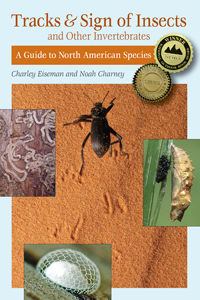In my last post, I wrote about case-bearing leaf beetle and green lacewing larvae that gather the trichomes from the undersides of sycamore leaves to make portable shelters. While I was taking pictures of the former, Noah was discovering a third type of sycamore trichome shelter that was unfamiliar to either of us. This one was a stationary retreat, and each example was surrounded by a patch of leaf that was denuded of trichomes. We determined that the shelters were made by little nondescript green caterpillars.
I collected a larva and it survived the trip from Kentucky back to Massachusetts (via Tennessee and Maryland), munching away on the sycamore leaves I had put in the bag with it. By the time I got home, about a week after I had collected it, the leaves were in pretty sorry shape, so when I spotted a sycamore tree in Northampton I grabbed a fresh leaf. While I was looking for a good leaf to take, I found a similar (but vacant) trichome shelter, presumably made by the same kind of caterpillar. When I put the fresh leaf in the bag, the caterpillar moved to it and built a new silken shelter (still incorporating some trichomes), fed for a while longer on the surrounding leaf tissue, and then pupated within the shelter.
When I went to Vermont last week, I brought my various bags of developing bugs with me, and on Thursday, June 30–about a month after I had collected the caterpillar–I discovered that the adult moth had emerged. I scanned through the list of sycamore-feeding larvae in the HOSTS database, and the two Gelechia species were the only ones I thought it could possibly be. I checked the photos of pinned specimens on the Moth Photographers Group website, here and here, and both looked pretty close. Based on feedback from Maury Heiman and Terry Harrison, I think that it is likely Gelechia albisparsella, and that Gelechia desiliens is a very similar western species whose larva may do the same thing (based on the statement here that the G. desiliens larva lives in a “tubular nest”). Terry pointed me to William T. M. Forbes’ (1923) Lepidoptera of New York and Neighboring States, which states that the G. albisparsella caterpillar lives “in a roll made of the down on the under side of the leaf.” Forbes lists Kentucky, Pennsylvania, and New York as the known locations for this moth. G. desiliens definitely occurs in western North America, but I haven’t found any indication from a reliable source of how far east its range extends. Maury pointed out some features of my moth that are more consistent with G. albisparsella than with G. desiliens, but Terry suggested that distinguishing them conclusively would require dissection or even DNA barcoding. I wonder how certain it is that these are even two different species. In any case, here’s what the moth that traveled from Kentucky to Vermont looks like:







Fascinating information here. Love the idea of this tiny creature building its “house” with materials harvested from a “forest” of leaf trichomes….structures which may have evolved in the first place as a defense against herbivores. Wonderful photography, too.
Pingback: Monthly Mystery #24: Magnolia Fuzz Harvester | BugTracks